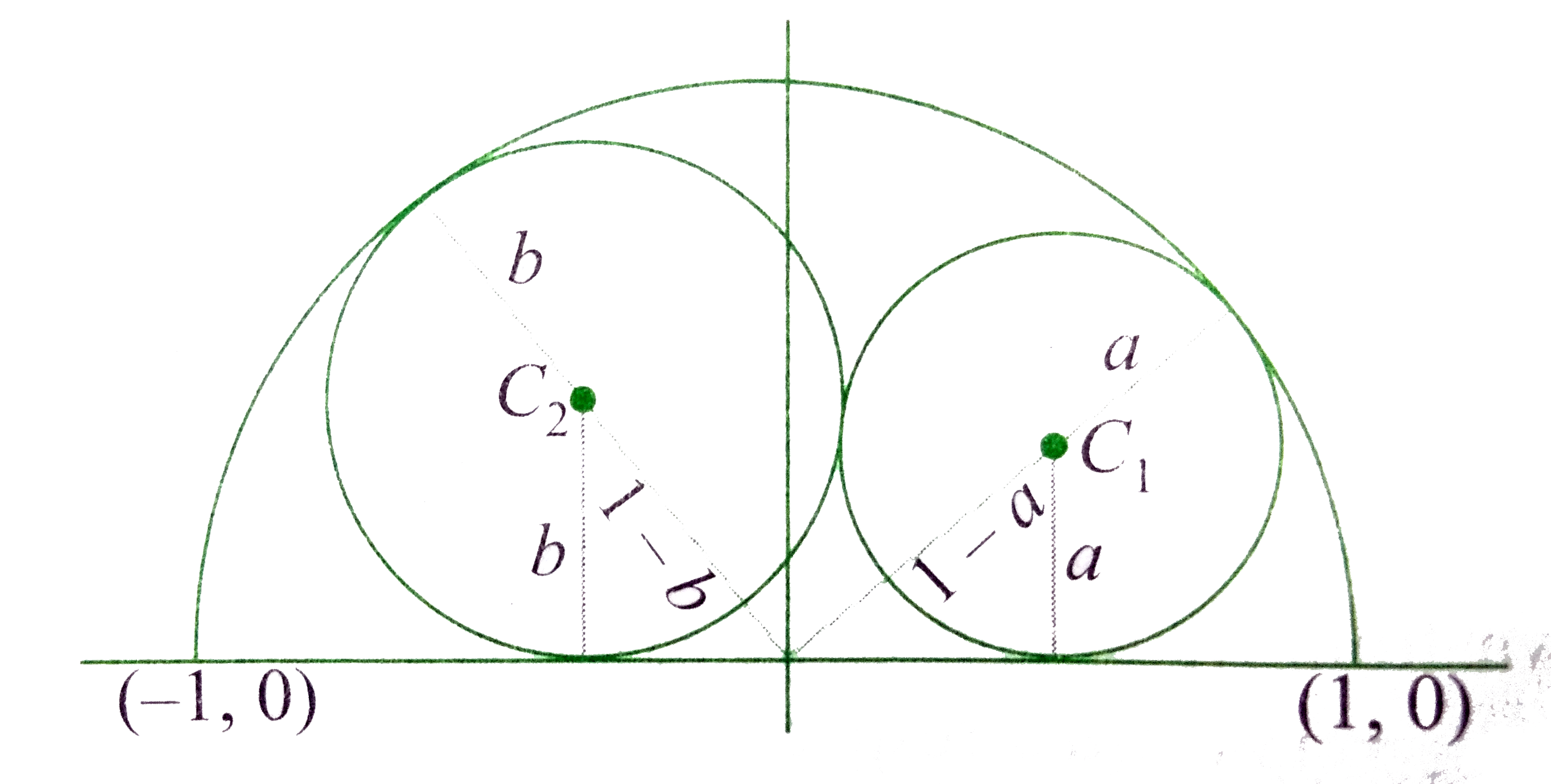Two circles of radii aandb touching each other externally, are inscribed in the area bounded by y=√1−x2 and the x-axis. If b=12, then a is equal to 14 (b) 18 (c) 12 (d) 1√2Solution in Bengali
1/4
1/8
1/2
1/√2
The correct Answer is:1

Let the centers of the circle be C1 and C2.
Then C1 is (√1−2a,a) and C2 is (√1−2b,b) . Now,
C1C2=a+b=a+12
or 1−2a+(a−12)2=(a+12)2
or a=14
Topper's Solved these Questions
- CIRCLE BOOK - CENGAGE PUBLICATIONCHAPTER - CIRCLE EXERCISE - Multiple Correct Anser Type
29 Videos
- CIRCLE BOOK - CENGAGE PUBLICATIONCHAPTER - CIRCLE EXERCISE - Linked Comprehension Type (For Problem 1-3)
3 Videos
- CIRCLE BOOK - CENGAGE PUBLICATIONCHAPTER - CIRCLE EXERCISE - CONCEPT APPLICATION EXERCISE 4.17
2 Videos
- BINOMIAL THEOREMBOOK - CENGAGE PUBLICATIONCHAPTER - BINOMIAL THEOREMEXERCISE - Comprehension
11 Videos
- CIRCLESBOOK - CENGAGE PUBLICATIONCHAPTER - CIRCLESEXERCISE - Comprehension Type
8 Videos
Similar Questions
about to only mathematics
View SolutionEach side of a square is of length 6 units and the centre of the square Is ( - 1, 2). One of its diagonals is parallel to x+y=0. Find the co-ordinates of the vertices of the square.
View SolutionThree concentric circles of which the biggest is x2+y2=1, have their radii in A.P If the line y=x+1 cuts all the circles in real and distinct points. The interval in which the common difference of the A.P will lie is:
View SolutionConsider a G.P. with first term (1+x)n, |x|<1, common ratio 1+x2 and number of terms (n+1). Let 'S' be sum of all the terms of the G.P., then
The coefficient of xn is 'S' is
View Solution
In the diagram as shown, a circle is drawn with centre C(1,1) and radius 1 and a line L. The line L is tangent to the circle at Q. Further L meets the y-axis at R and the x-axis at P in such a way that the angle OPQ equals θ where 0<θ<π2.
Coordinate of Q is
View SolutionThe radius of a circle,having minimum area, which touches the curve y=4-x^(2) and the lines,y=|x| is: (a) 4(sqrt(2)+1)( b) 2(sqrt(2)+1) (c) 2(sqrt(2)-1)( d) 4(sqrt(2)-1)
View SolutionIf ∫ln(x+√1+x2)√1+x2dx=a√1+x2ln(x+√1+x2)+bx+c , then (A) a=1,b=−1 (B) a=1,b=1 (C) a=−1,b=1 (D) a=−1,b=−1
View SolutionTwo circles of radii aandb touching each other externally, are inscribed in the area bounded by y=√1−x2 and the x-axis. If b=12, then a is equal to 14 (b) 18 (c) 12 (d) 1√2
View Solutionint(x+sqrt(1+x^(2)))^(n)dx=A(x+sqrt(1+x^(2)))^(n+1)+B(x+sqrt(1+x^(2)))^(n-1)+c then (1)/(A)+(1)/(B)=
View SolutionTangents drawn from (2,0) to the circle x2+y2=1 touch the circle at AandB. Then (A) A≡(12,√32), B -= (-1/2, - sqrt(3)/2)(B)A-= (- 1/2, (-sqrt(3)/2),B≡(12,√32) (C) A≡(12,√32), B-= (1/2, - sqrt(3)/2) (D) A≡(12,−√32),B≡(12,√32)
View SolutionThe area of the figure bounded by the curves y=cosx and y=sinx and the ordinates x=0 and x=π4 is (A) √2−1 (B) √2+1 (C) 1√2(√2−1) (D) 1√2
View SolutionThe area bounded by the curve y=secx, the x-axis and the lines x=0 and x=π4 is (A) log(√2+1) (B) log(√2−1) (C) 12log2 (D) √2
View Solutionयदि प्रत्येक b>1 के लिए, y=f(x),x=1,x=b तथा x-अक्ष से घिरे क्षेत्र का क्षेत्रफल √b2+1−√2 हो, तो f(x) है :
View Solutionddx(sin−1x+cos−1x) is equal to : (A) 1√1−x2, (B) 2√1−x2, (C) 0 (D) √1−x2
View SolutionThe area bounded by the X-axis, the cure y = f(x) and the lines x = 1 and x = b is equal to √b2+1−√2 for all b>1 then f(x) is
View SolutionThe area bounded by the x-axis, the curve y=f(x), and the lines x=1,x=b is equal to √b2+1−√2 for all b>1, then f(x) is
View Solution
